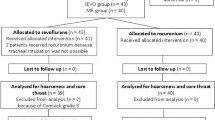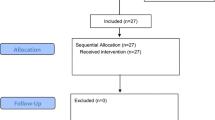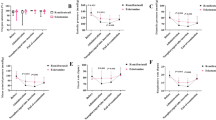Abstract
Purpose
The aim of this study was to compare tracheal intubation conditions after induction of anesthesia with a bolus of propofol-sufentanil or propofol-remifentanil and a rapid induction technique.
Material and methods
A total of 70 patients (American Society of Anesthesiologists (ASA) classification I‑II) undergoing outpatient surgery under general anesthesia with intubation for tooth extraction were randomly assigned to two groups in this double-blind study. Patients received either a bolus of remifentanil (3 μg/kg) or sufentanil (0.3 μg/kg) together with 2.5 mg/kg propofol for intubation. The primary outcome was the percentage of excellent intubation conditions and the secondary outcomes were the percentage of patients with a decrease of over 20% in mean arterial pressure (MAP) or heart rate (HR), time to achieve spontaneous respiration, time between the end of surgery and extubation and time to achieve an Aldrete score of 10. VAS pain score was >3 or having laryngeal pain 15 min after arriving in the postanesthesia care unit (PACU) were also analyzed.
Results
Intubating conditions (perfect + good conditions) were significantly better with remifentanil than with sufentanil (88.5% vs. 68.6%; p = 0.01). When using remifentanil, the hemodynamic conditions were good. Using remifentanil did not significantly increase the pain score or the laryngeal pain in the recovery room. This was confirmed by no significant differences between the groups for morphine consumption. Remifentanil significantly decreased the time to achieve an Aldrete score of 10.
Conclusion
When intubation without muscle relaxants is required, intubating conditions are much better when a remifentanil bolus is used compared to a sufentanil bolus. The remifentanil/propofol rapid induction technique is a valuable technique to quickly intubate and achieve good conditions.
Zusammenfassung
Zweck
Ziel dieser Studie war es, die Bedingungen der Trachealintubation nach Narkoseeinleitung mit einem Bolus Propofol-Sufentanil oder Propofol-Remifentanil und einer schnellen Induktionstechnik zu vergleichen.
Material und Methoden
In dieser Doppelblindstudie wurden insgesamt 70 Patienten (American Society of Anesthesiologists(ASA)-Klassifikation I–II), bei denen ambulant unter Vollnarkose mit Intubation eine Operation zur Zahnextraktion durchgeführt wurde, in 2 Gruppen randomisiert. Die Patienten erhielten entweder einen Bolus Remifentanil (3 μg/kg) oder Sufentanil (0,3 μg/kg), zusammen mit 2,5 mg/kg Propofol zur Intubation. Das primäre Ergebnis war der Prozentsatz ausgezeichneter Intubationsbedingungen, und die sekundären Ergebnisse waren der prozentuale Anteil der Patienten mit einer Senkung des mittleren arteriellen Drucks (MAP) oder der Herzfrequenz (HR) um mehr als 20 %, die Zeit bis zum Erreichen der Spontanatmung, die Zeit zwischen dem Ende der Operation und der Extubation sowie die Zeit bis zum Erreichen eines Aldrete-Scores von 10. Der prozentuale Anteil der Patienten mit einem Schmerzscore >3 oder mit Kehlkopfschmerzen 15 min nach Ankunft auf der „postanesthesia care unit“ (PACU) wurde ebenfalls analysiert.
Ergebnisse
Die Intubationsbedingungen waren mit Remifentanil signifikant besser als mit Sufentanil (51,4 % vs. 20 %; p = 0,0064). Bei der Verwendung von Remifentanil waren die hämodynamischen Bedingungen gut. Die Verwendung von Remifentanil führte zu keiner signifikanten Erhöhung des Schmerzscores oder der Kehlkopfschmerzen im Aufwachraum. Dies wurde dadurch bestätigt, dass es keine signifikanten Unterschiede in den Gruppen für die Morphineinnahme gab. Remifentanil verkürzte die Zeit bis zum Erreichen eines Aldrete-Scores von 10 signifikant.
Schlussfolgerung
Wenn eine Intubation ohne Muskelrelaxanzien erforderlich ist, sind die Intubationsbedingungen bei Verwendung eines Remifentanil-Bolus wesentlich besser als bei Verwendung eines Sufentanil-Bolus. Die Methode der schnellen Induktion durch Remifentanil/Propofol ist eine wertvolle Technik, mit der eine schnelle Intubation möglich ist und gute Bedingungen erreicht werden können.




Similar content being viewed by others
Abbreviations
- ASA:
-
American Society of Anesthesiologists
- BMI:
-
Body mass index
- HR:
-
Heart rate
- IDS:
-
Intubation difficulty scale
- IV:
-
Intravenous
- MAP:
-
Mean arterial pressure
- PACU:
-
Post anesthesia care unit
- SpO2 :
-
Oxygen saturation
- VAS:
-
Visual analog scale
References
Baillard C, Adnet F, Borron SW et al (2005) Tracheal intubation in routine practice with and without muscular relaxation: an observational study. Eur J Anaesthesiol 22:672–677
Heerdt PM, Sunaga H, Savarese JJ (2015) Novel neuromuscular blocking drugs and antagonists. Curr Opin Anaesthesiol 28:403–410
Bulka CM, Terekhov MA, Martin BJ, Dmochowski RR, Hayes RM, Ehrenfeld JM (2016) Nondepolarizing neuromuscular blocking agents, reversal, and risk of postoperative pneumonia. Anesthesiology 125:647–655
Grosse-Sundrup M, Henneman JP, Sandberg WS et al (2012) Intermediate acting non-depolarizing neuromuscular blocking agents and risk of postoperative respiratory complications: prospective propensity score matched cohort study. BMJ 345:e6329
Kirmeier E, Eriksson LI, Lewald H et al (2019) Post-anaesthesia pulmonary complications after use of muscle relaxants (POPULAR): a multicentre, prospective observational study. Lancet Respir Med 7(2):129–140. https://doi.org/10.1016/S2213-2600(18)30294-7
Combes X, Andriamifidy L, Dufresne E et al (2007) Comparison of two induction regimens using or not using muscle relaxant: impact on postoperative upper airway discomfort. Br J Anaesth 99:276–281
Laxenaire MC, Auroy Y, Clergue F, Péquignot F, Jougla E, Lienhart A (1998) Organization and techniques of anesthesia. Ann Fr Anesth Reanim 17:1317–1323
Alexander R, Olufolabi AJ, Booth J, El-Moalem HE, Glass PS (1999) Dosing study of remifentanil and propofol for tracheal intubation without the use of muscle relaxants. Anaesthesia 54:1037–1040
Adamus M, Koutná J, Gabrhelík T, Zapletalová J (2008) Tracheal intubation without muscle relaxant—the impact of different sufentanil doses on the quality of intubating conditions: a prospective study. Cas Lek Cesk 147:96–101
Minto CF, Schnider TW, Shafer SL (1997) Pharmacokinetics and pharmacodynamics of remifentanil. II. Model application. Anesthesiology 86:24–33
Alexander R, Booth J, Olufolabi AJ, El-Moalem HE, Glass PS (1999) Comparison of remifentanil with alfentanil or suxamethonium following propofol anaesthesia for tracheal intubation. Anaesthesia 54:1032–1036
Demirkaya M, Kelsaka E, Sarihasan B, Bek Y, Üstün E (2012) The optimal dose of remifentanil for acceptable intubating conditions during propofol induction without neuromuscular blockade. J Clin Anesth 24:392–397
Bouvet L, Stoian A, Rimmelé T, Allaouchiche B, Chassard D, Boselli E (2009) Optimal remifentanil dosage for providing excellent intubating conditions when co-administered with a single standard dose of propofol. Anaesthesia 64:719–726
Trabold F, Casetta M, Duranteau J et al (2004) Propofol and remifentanil for intubation without muscle relaxant: the effect of the order of injection. Acta Anaesthesiol Scand 48:35–39
Hanna SF, Ahmad F, Pappas ALS et al (2010) The effect of propofol/remifentanil rapid-induction technique without muscle relaxants on intraocular pressure. J Clin Anesth 22:437–442
Gulhas N, Topal S, Erdogan Kayhan G et al (2013) Remifentanil without muscle relaxants for intubation in microlaryngoscopy: a double blind randomised clinical trial. Eur Rev Med Pharmacol Sci 17:1967–1973
Naziri F, Amiri HA, Rabiee M et al (2015) Endotracheal intubation without muscle relaxants in children using remifentanil and propofol: comparative study. Saudi J Anaesth 9:409–412
Erhan E, Ugur G, Alper I, Gunusen I, Ozyar B (2003) Tracheal intubation without muscle relaxants: remifentanil or alfentanil in combination with propofol. Eur J Anaesthesiol 20:37–43
Stevens JB, Wheatley L (1998) Tracheal intubation in ambulatory surgery patients: using remifentanil and propofol without muscle relaxants. Anesth Analg 86:45–49
Fuchs-Buder T, Claudius C, Skovgaard LT et al (2007) Good clinical research practice in pharmacodynamic studies of neuromuscular blocking agents II: the Stockholm revision. Acta Anaesthesiol Scand p:789–808
Adnet F, Borron SW, Racine SX et al (1997) The intubation difficulty scale (IDS): proposal and evaluation of a new score characterizing the complexity of endotracheal intubation. Anesthesiology 87:1290–1297
Hanci V (2012) Tracheal intubation without use of muscle relaxants: comparison of remifentanil and alfentanil. Anesth Pain Med 1:210–211
Scheller MS, Zornow MH, Saidman LJ (1992) Tracheal intubation without the use of muscle relaxants: a technique using propofol and varying doses of alfentanil. Anesth Analg 75:788–793
Jabbour-Khoury SI, Dabbous AS, Rizk LB et al (2003) A combination of alfentanil-lidocaine-propofol provides better intubating conditions than fentanyl-lidocaine-propofol in the absence of muscle relaxants. Can J Anaesth 50:116–120
Klemola UM, Mennander S, Saarnivaara L (2000) Tracheal intubation without the use of muscle relaxants: remifentanil or alfentanil in combination with propofol. Acta Anaesthesiol Scand 44:465–469
Goo E‑K, Oh A‑Y, Cho S‑J, Seo K‑S, Jeon Y‑T (2012) Optimal remifentanil dosage for intubation without muscle relaxants in elderly patients. Drugs Aging 29:905–909
Acknowledgements
The authors thank Leonie Smith for the English editing of this article.
Funding
Support was provided solely from institutional and department sources. CHU Toulouse supported this work.
Author contributions
Conceived and designed the experiments: CR, VM. Performed the experiments: CR, LB, FF, AD. Wrote the paper: JMC, AD, LB, CR, VM.
Author information
Authors and Affiliations
Corresponding author
Ethics declarations
Conflict of interest
A. Dolsan, L. Bruneteau, C. Roche, F. Ferré, F. Labaste, A. Sommet, J.-M. Conil and V. Minville declare that they have no competing interests..
Ethical standards
All procedures performed in studies involving human participants or on human tissue were in accordance with the ethical standards of the institutional and/or national research committee and with the 1975 Helsinki declaration and its later amendments or comparable ethical standards. This study was approved by the research ethics board (protocol number 09.001.03, favorable opinion of the CPP Sud-Ouest et Outre-Mer 1) and written informed consent was obtained from each patient. This trial was registered at ClinicalTrials.gov (NCT01910285 dated July 29, 2013)
Additional information
The authors A. Dolsan and L. Bruneteau contributed equally to the manuscript.
Rights and permissions
About this article
Cite this article
Dolsan, A., Bruneteau, L., Roche, C. et al. Comparison of intubating conditions after induction with propofol and remifentanil or sufentanil. Anaesthesist 69, 262–269 (2020). https://doi.org/10.1007/s00101-020-00739-0
Received:
Revised:
Accepted:
Published:
Issue Date:
DOI: https://doi.org/10.1007/s00101-020-00739-0




